What the Well-Dressed Spacecraft Will Be Wearing

This coming February, the Cygnus NG-17 spacecraft will launch from NASA Wallops, in Virginia, on a routine resupply mission to the International Space Station. Amid the many tonnes of standard crew supplies, spacewalk equipment, computer hardware, and research experiments will be one unusual package: a pair of electronic textile swatches embedded with impact and vibration sensors. Soon after the spacecraft's arrival at the ISS, a robotic arm will mount the samples onto the exterior of Alpha Space's Materials ISS Experiment (MISSE) facility, and control-room operators back on Earth will feed power to the samples.
For the next six months, our team will conduct the first operational test of sensor-laden electronic fabrics in space, collecting data in real time as the sensors endure the harsh weather of low Earth orbit. We also hope that microscopic dust or debris, traveling at least an order of magnitude faster than sound, will strike the fabric and trigger the sensors.
Our eventual aim is to use such smart electronic textiles to study cosmic dust, some of which has interplanetary or even interstellar origins. Imagine if the protective fabric covering a spacecraft could double as an astrophysics experiment, but without adding excessive mass, volume, or power requirements. What if this smart skin could also measure the cumulative damage caused by orbital space debris and micrometeoroids too small to be tracked by radar? Could sensored textiles in pressured spacesuits give astronauts a sense of touch, as if the fabric were their own skin? In each case, electronic fabrics sensitive to vibrations and charge could serve as a foundational technology.
Already, engineered fabrics serve crucial functions here on Earth. Geotextiles made of synthetic polymers are buried deep underground to strengthen land embankments. Surgical meshes reinforce tissue and bone during invasive medical procedures.
In space, the outer walls of the ISS are wrapped in a protective engineered textile that gives the station its white color. Called Beta cloth, the woven fabric covers the station's metal shell and shields the spacecraft from overheating and erosion. Beta cloth can also be found on the exterior of Apollo-era spacesuits and Bigelow Aerospace's next-generation inflatable habitats. Until it is possible to substantially alter the human body itself, resilient textiles like this will continue to serve as a crucial boundary-a second skin-protecting human explorers and spacecraft from the extremes of space.
Now it's time to bring some smarts to this skin.
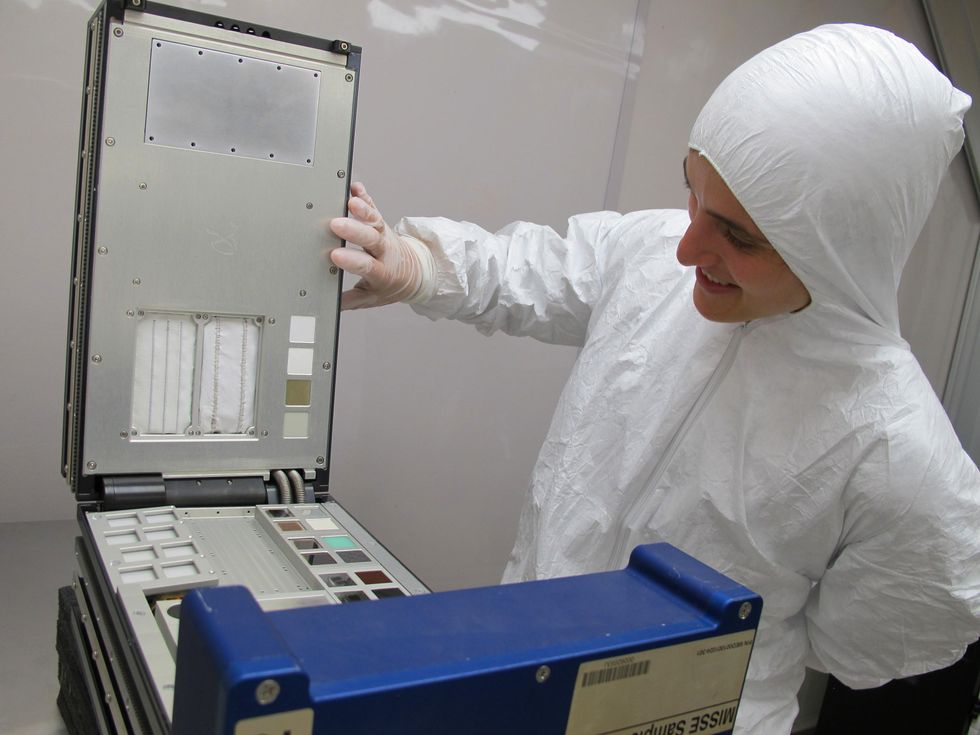
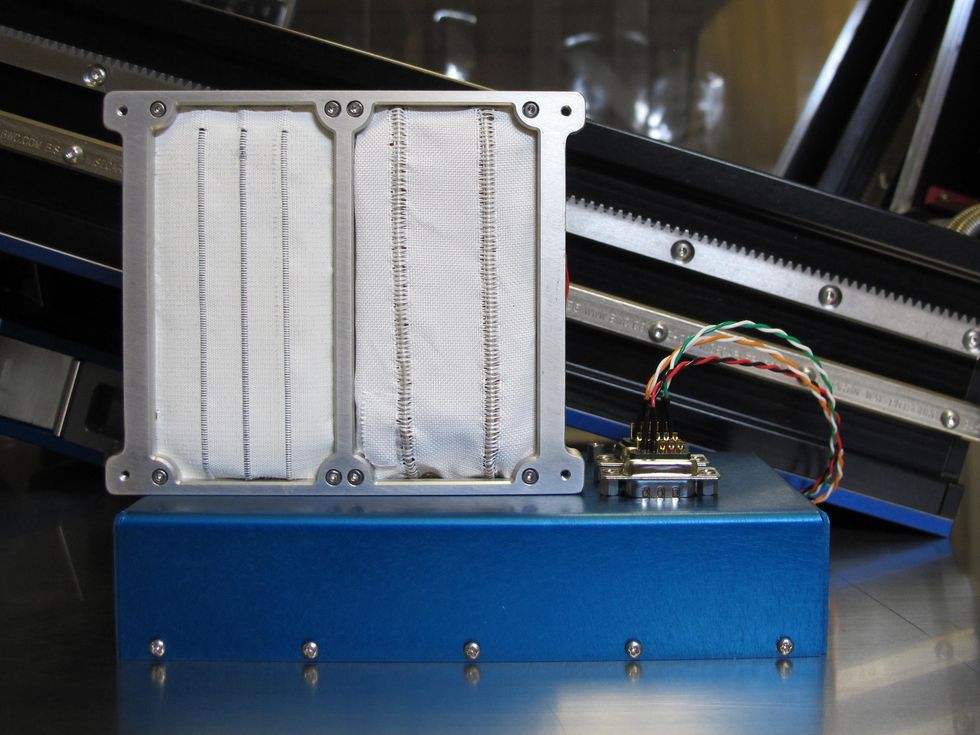 Juliana Cherston prepares a smart-fabric system in the clean room at Alpha Space in Houston [top]. Electronics in the silver flight hardware box [bottom] stream data to the computer in the blue box. The system, set for launch in February, will be mounted on the Materials ISS Experiment facility.Allison Goode/Aegis Aerospace
Juliana Cherston prepares a smart-fabric system in the clean room at Alpha Space in Houston [top]. Electronics in the silver flight hardware box [bottom] stream data to the computer in the blue box. The system, set for launch in February, will be mounted on the Materials ISS Experiment facility.Allison Goode/Aegis Aerospace
Our lab, the Responsive Environments Group at MIT, has been working for well over a decade on embedding distributed sensor networks into flexible substrates. In 2018, we were knee-deep in developing a far-out concept to grapple an asteroid with an electronic web, which would allow a network of hundreds or thousands of tiny robots to crawl across the surface as they characterized the asteroid's materials. The technology was curious to contemplate but unlikely to be deployed anytime soon. During a visit to our lab, Hajime Yano, a planetary scientist at the Japan Aerospace Exploration Agency's Institute of Space and Astronautical Science, suggested a nearer-term possibility: to turn the Beta cloth blanket used on long-duration spacecraft into a science experiment. Thus began a collaboration that has so far resulted in multiple rounds of prototyping and ground testing and two experiments in space.
One of the tests is the upcoming launch aboard the Cygnus NG-17, funded by the ISS National Laboratory. As the ISS orbits Earth, and the local space environment changes, we'll be triggering our sensors with known excitations to measure how their sensitivity varies over time. Concurrently, we'll take impedance measurements, which will let us peek into the internal electrical properties of the fibers. Any changes to the protective capabilities of the Beta fabric will be picked up using temperature sensors. If the system functions as designed, we may even detect up to 20 micrometeoroid impacts across the fabric's 10-by-10-centimeter area. A triggering system will flag any interesting data to be streamed to Earth in real time.
A second in-space experiment is already underway. For more than a year, a wider range of our smart-fabric swatches has been quietly tucked away on a different section of the ISS's walls, on Space BD's Exposed Experiment Handrail Attachment Mechanism (ExHAM) facility. In this experiment, funded by the MIT Media Lab Space Exploration Initiative, the samples aren't being powered. Instead, we're monitoring their exposure to the space environment, which can be tough on materials. They endure repeated cycles of extreme heat and cold, radiation, and material-eroding atomic oxygen. Through real-time videography sessions we've been conducting with the Japan Aerospace Exploration Agency (JAXA), we've already seen signs of some anticipated discoloration of our samples. Once the samples return to Earth in late January via the SpaceX CRS-24 rocket, we'll conduct a more thorough evaluation of the fabrics' sensor performance.
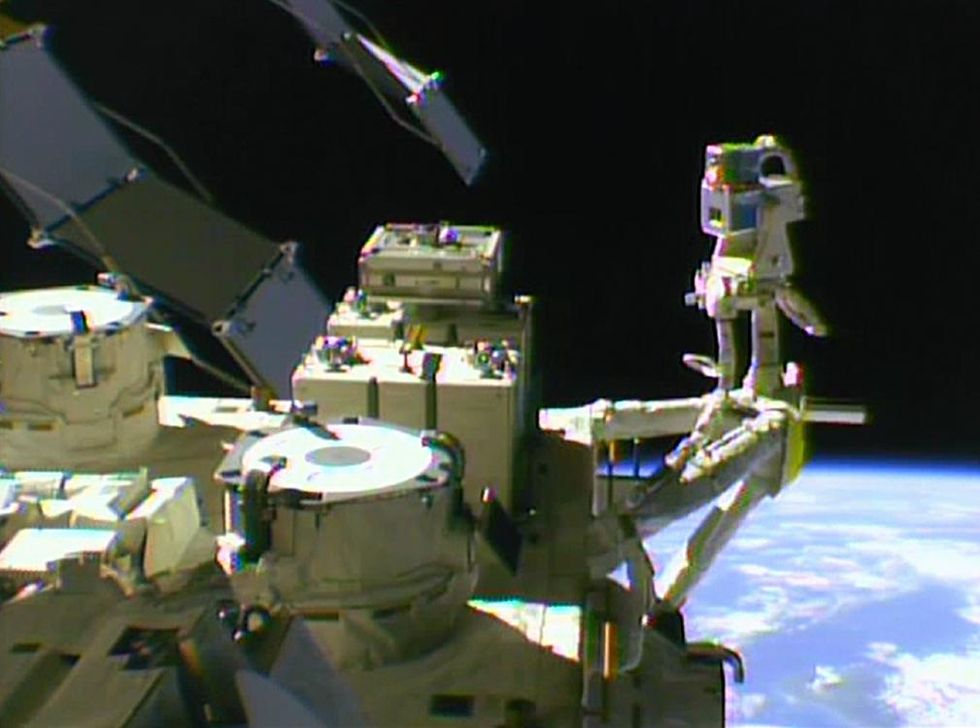
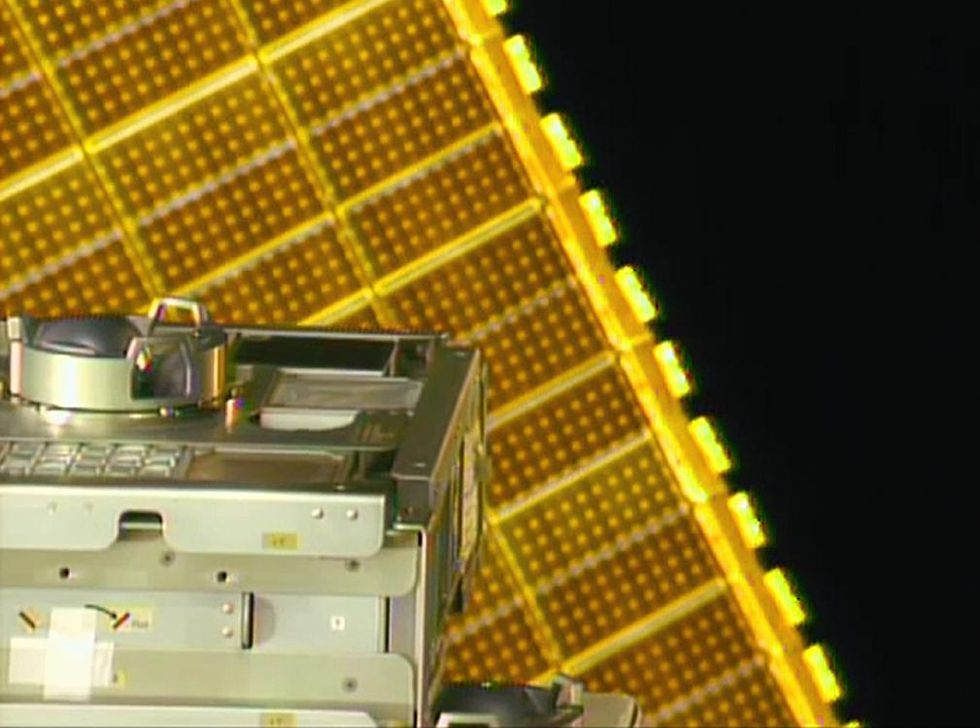
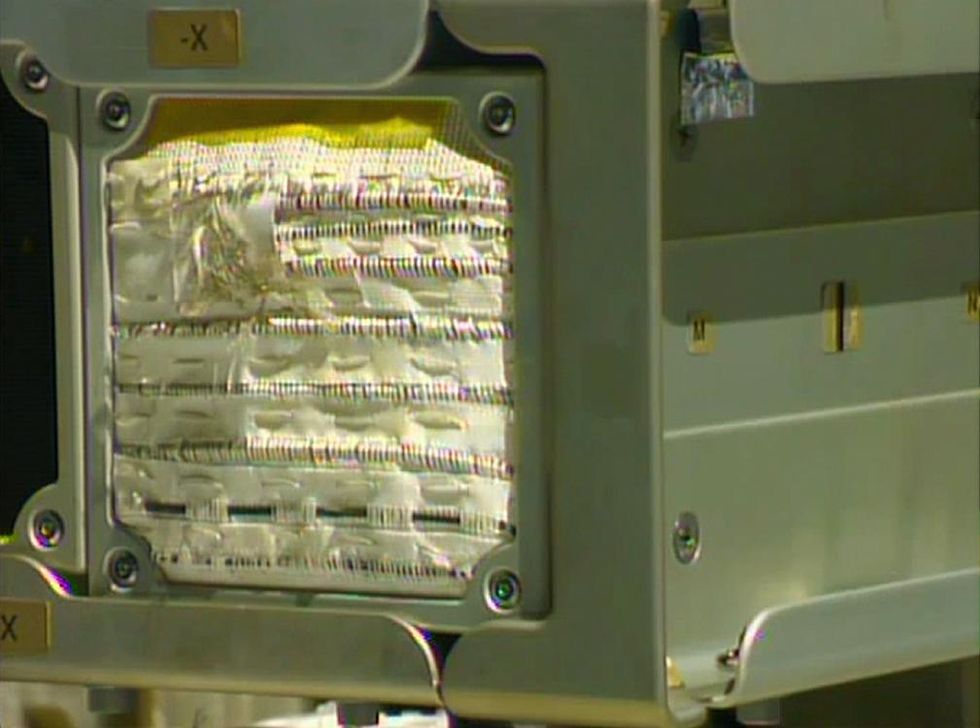 A video inspection shows sensored fabrics mounted on the Exposed Experiment Handrail Attachment Mechanism (ExHAM) facility on the International Space Station. The experiment, which began in October 2020, is studying the resiliency of different types of fabric sensors when they're exposed to the harsh environment of low Earth orbit.JAXA/Space BD
A video inspection shows sensored fabrics mounted on the Exposed Experiment Handrail Attachment Mechanism (ExHAM) facility on the International Space Station. The experiment, which began in October 2020, is studying the resiliency of different types of fabric sensors when they're exposed to the harsh environment of low Earth orbit.JAXA/Space BD
By demonstrating how to sleekly incorporate sensors into mission-critical subsystems, we hope to encourage the widespread adoption of electronic textiles as scientific instrumentation.
Electronic textiles got an early and auspicious start in space. In the 1960s, the software for the Apollo guidance computer was stored in a woven substrate called core rope memory. Wires were fed through conductive loops to indicate 1s and around loops to indicate 0s, achieving a memory density of 72 kilobytes per cubic foot (or about 2,500 kilobytes per cubic meter).
Around the same time, a company called Woven Electronics (now part of Collins Aerospace) began developing fabric circuit board prototypes that were considered well ahead of their time. For a fleeting moment in computing, woven fabric circuits and core rope memory were competitive with silicon semiconductor technology.
Electronic fabrics then fell into a long hiatus, until interest in wearable technology in the 1990s revived the idea. Our group pioneered some early prototypes, working, for instance, with Levi's in the late '90s on a jean jacket with an embroidered MIDI keyboard. Since then, researchers and companies have created a plethora of sensing technologies in fabric, especially for health-related wearables, like flexible sensors worn on the skin that monitor your well-being through your sweat, heart rate, and body temperature.
More recently, sophisticated fiber sensors have been pushing the performance and capabilities of electronic textiles even further. Our collaborators in the Fibers@MIT group, for example, use a manufacturing technique called thermal drawing, in which a centimeter-thick sandwich of materials is heated and stretched to submillimeter thickness, like pulling a multicolored taffy. Incredibly, the internal structure of the resulting fiber remains highly precise, yielding functional devices such as sensors for vibration, light, and temperature that can be woven directly into fabrics.
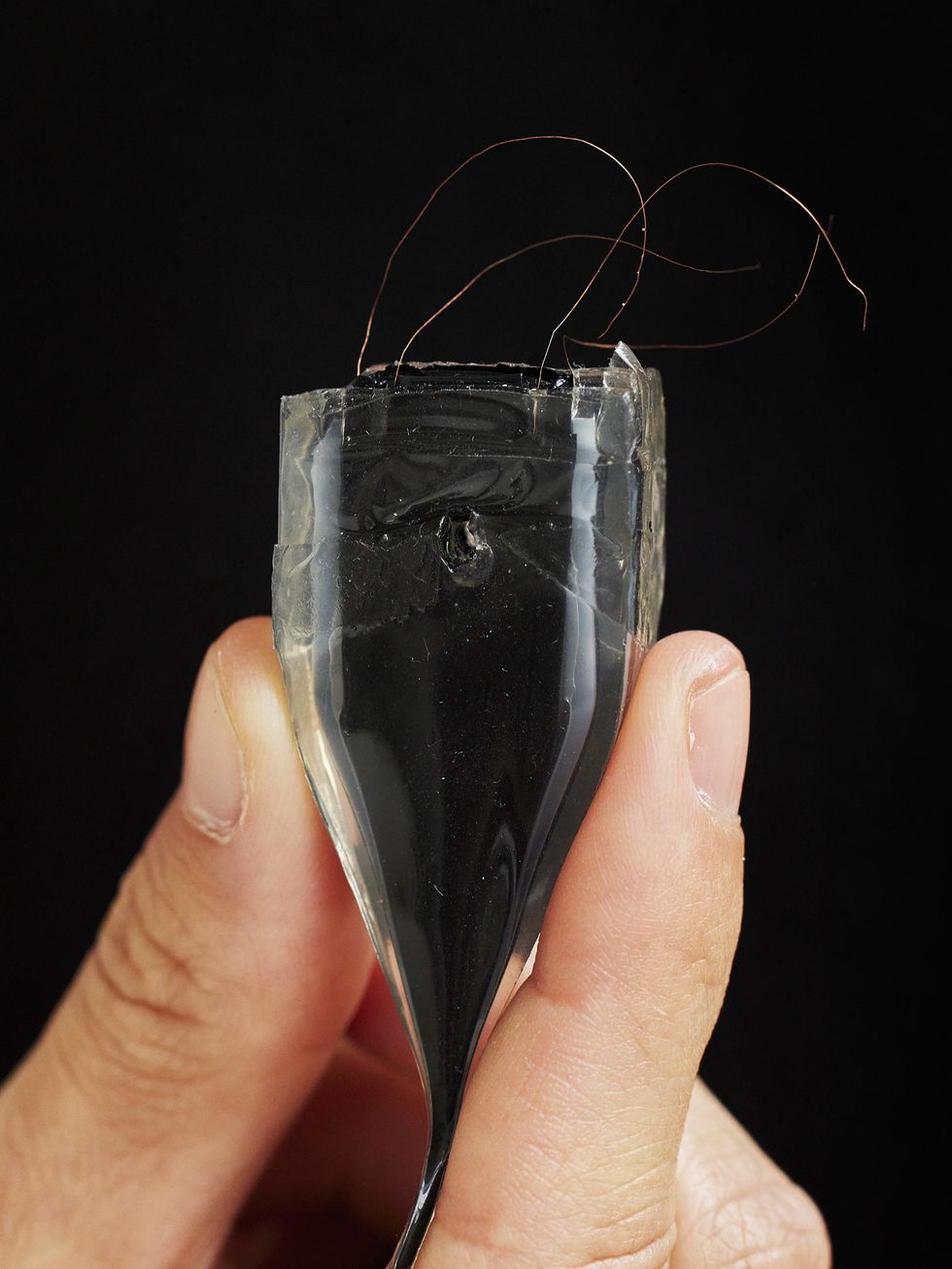
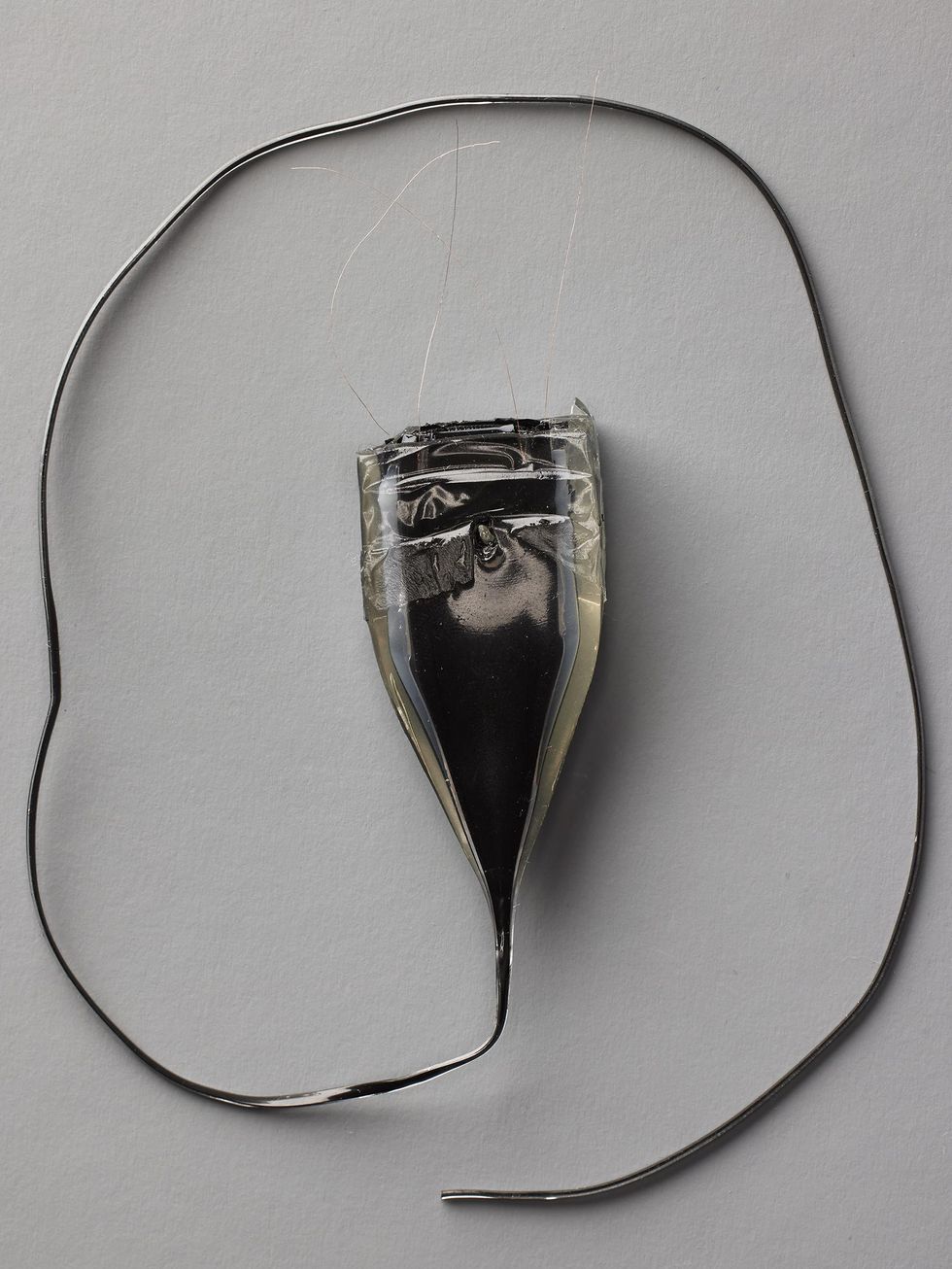 To make a piezoelectric fiber sensor, researchers at the Fibers@MIT group sandwich materials together and then heat and stretch them like taffy. The faint copper wires are used to make electrical contact with the materials inside the fiber. The fibers can then be woven into Beta cloth.Bob O'Connor
To make a piezoelectric fiber sensor, researchers at the Fibers@MIT group sandwich materials together and then heat and stretch them like taffy. The faint copper wires are used to make electrical contact with the materials inside the fiber. The fibers can then be woven into Beta cloth.Bob O'Connor
But this exciting progress hasn't yet made its way to space textiles. Today's spacesuits aren't too different from the one that Alan Shepard wore inside Freedom 7 in 1961. Recent suit designs have instead focused on improving the astronaut's mobility and temperature regulation. They might have touch-screen-compatible fingertips, but that's about as sophisticated as the functionality gets.
Meanwhile, Beta cloth has been used on space habitats in more or less its present form for more than a half century. A smattering of fabric antennas and fiber-optic strain sensors have been developed for rigid composites. But little has been done to add electronic sensory function to the textiles we use in space.
To jump-start this research, our group has tackled three areas: We've built fabric sensors, we've worked with specialized facilities to obtain a baseline of the materials' sensitivity to impact, and we've designed instrumentation to test these fabrics in space.
We started by upgrading Beta cloth, which is a Teflon-impregnated fabric made of flexible fiberglass filaments that are so densely woven that the material feels almost like a thick sheet of paper. To this protective layer, we wanted to add the ability to detect the tiny submillimeter or micrometer-scale impacts from cosmic dust. These microparticles move fast, at speeds of up to 50 kilometers per second, with an average speed of around 10 km/s. A 10-micrometer iron-dominant particle traveling at that speed contains about 75 microjoules of kinetic energy. It isn't much energy, but it can still carry quite a punch when concentrated to a small impact area. Studying the kinematics and spatial distributions of such impacts can give scientists insight into the composition and origins of cosmic dust. What's more, these impacts can cause significant damage to spacecraft, so we'd like to measure how frequent and energetic they are.
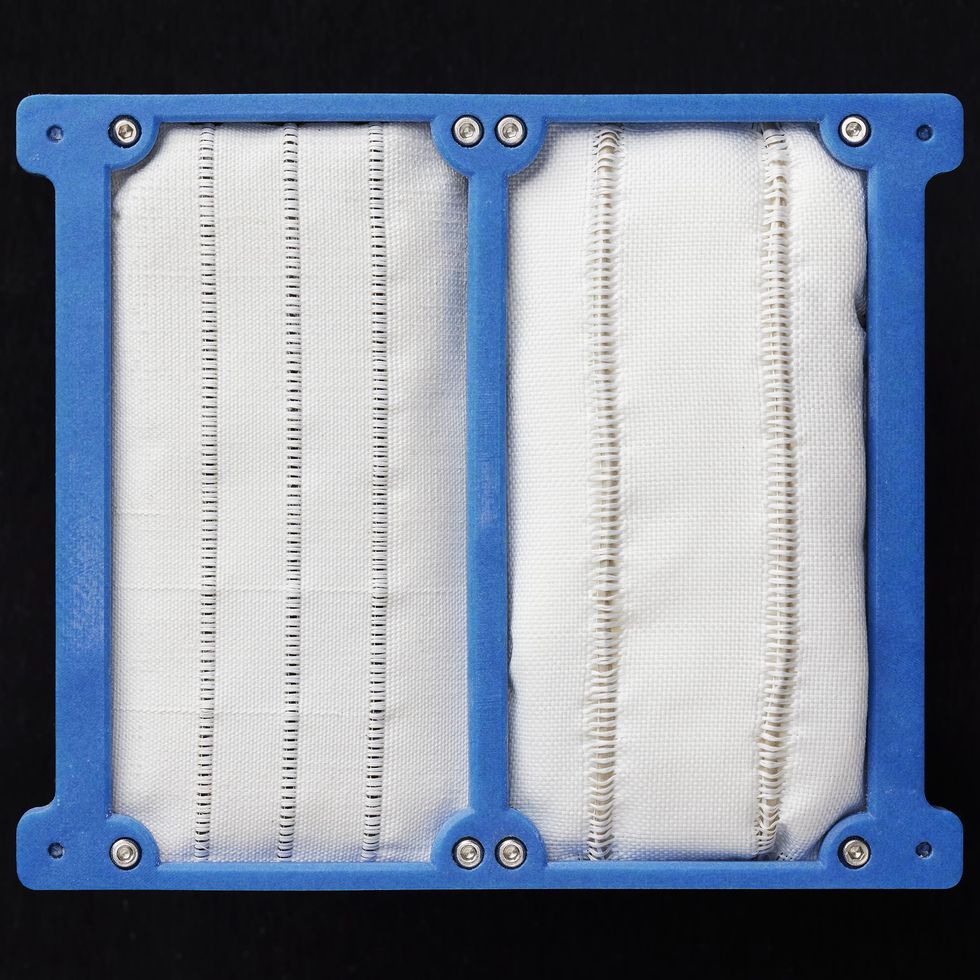
 A replica of the smart-fabric payload that's launching in February shows the electronics and internal layers.Bob O'Connor
A replica of the smart-fabric payload that's launching in February shows the electronics and internal layers.Bob O'Connor
What kind of fabric sensors would be sensitive enough to pick up the signals from these minuscule impacts? Early on, we settled on using piezoelectric fibers. Piezoelectric materials produce surface charge when subject to mechanical deformation. When a piezoelectric layer is sandwiched between two electrodes, it forms a sensor that can translate mechanical vibration into current. Piezoelectric impact sensors have been used on spacecraft before, but never as part of a fabric or as dispersed fibers.
One of the chief requirements for piezoelectrics is that the electric dipoles inside the material must all be lined up in order for the charge to accumulate. To permanently align the dipoles-a process called poling-we have to apply a substantial electric field of about 100 kilovolts for every millimeter of thickness.
Early on, we experimented with weaving bare polyvinylidene difluoride yarn into Beta cloth. This single-material yarn has the advantage of being as fine and flexible as the fibers in clothing and is also radiation- and abrasion-resistant. Plus, the fiber-drawing process creates a crystalline phase structure that encourages poling. Applying a hefty voltage to the fabric, though, caused any air trapped in the porous material to become electrically conductive, inducing miniature lightning bolts across the material and spoiling the poling process. We tried a slew of tricks to minimize the arcing, and we tested piezoelectric ink coatings applied to the fabric.
Imagine if the protective fabric covering a spacecraft could double as an astrophysics experiment, but without adding excessive mass, volume, or power requirements.
Ultimately, though, we determined that multimaterial fiber sensors were preferable to single-material yarns, because the dipole alignment needs to occur only across the very tiny and precise distances within each fiber sensor, rather than across a fabric's thickness or across a fabric coating's uneven surface. We chose two different fiber sensors. One of the fibers is a piezoceramic nanocomposite fiber designed by Fibers@MIT, and the other is a polymer we harvested from commercial piezoelectric cabling, then modified to be suitable for fabric integration. We coated these fiber sensors in an elastomeric conductive ink, as well as a white epoxy that keeps the fibers cool and resists oxidation.
To produce our fabric, we worked with space-textile manufacturer JPS Composite Materials, in Anderson, S.C. The company helped insert our two types of piezoelectric fibers at intervals across the fabric and ensured that our version of Beta cloth still adhered to NASA specifications. We have also worked with the Rhode Island School of Design on fabric manufacturing.
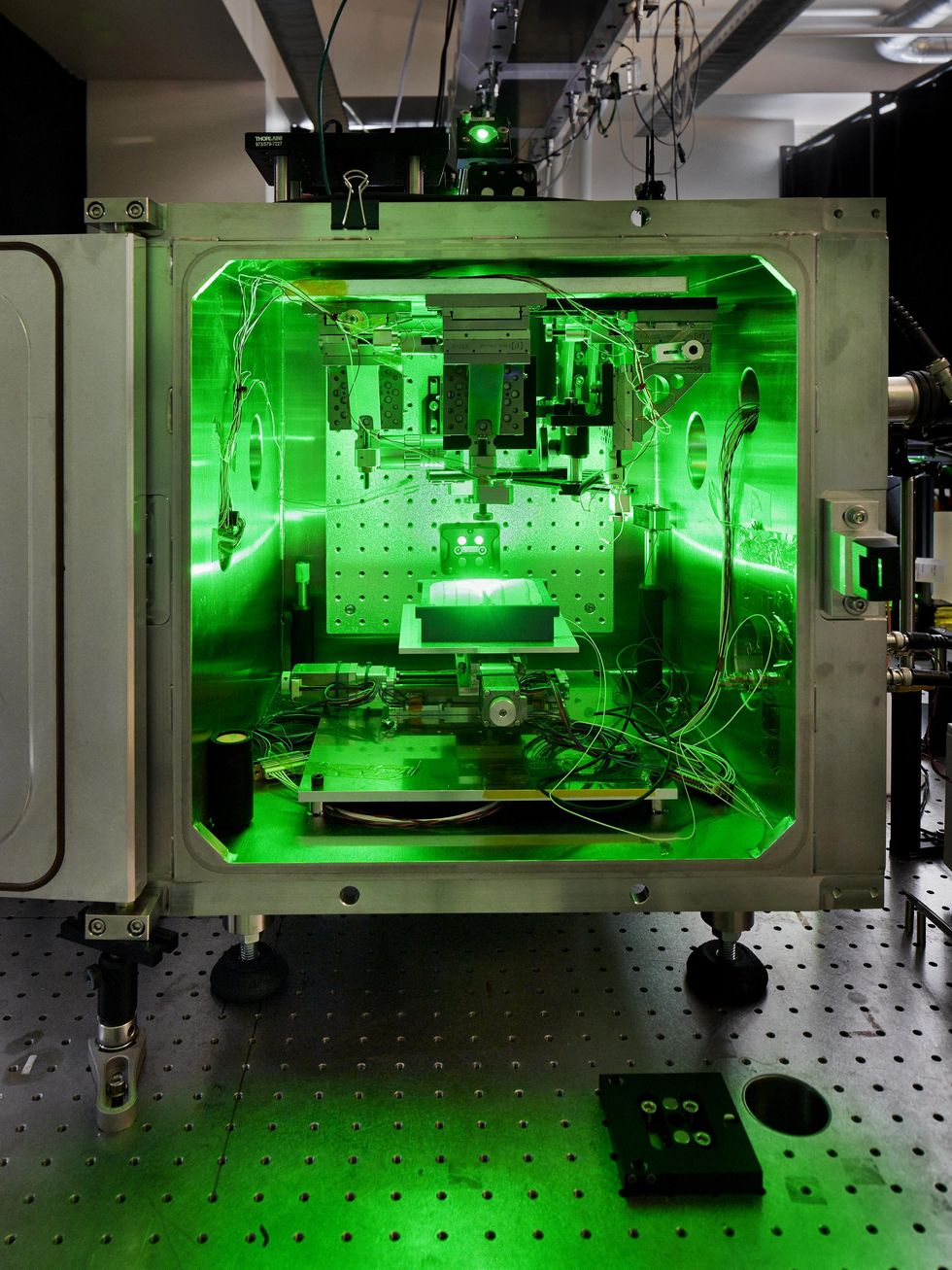 The green laser in the Laser-Induced Particle Impact Test facility at MIT's Institute for Soldier Nanotechnologies accelerates particles to supersonic speeds.Bob O'Connor
The green laser in the Laser-Induced Particle Impact Test facility at MIT's Institute for Soldier Nanotechnologies accelerates particles to supersonic speeds.Bob O'Connor
To test the sensitivity of our fabric, we have been using the Laser-Induced Particle Impact Test (LIPIT) platform designed by Keith Nelson's group at MIT's Institute for Soldier Nanotechnologies. This benchtop apparatus is designed for investigating how materials respond to microparticle impacts, such as in needle-free drug delivery and cold-sprayed industrial coatings. In our tests, we used the platform's high-speed particles to simulate space dust.
In a typical experiment, we spread steel particles ranging from a few micrometers to tens of micrometers onto gold film atop a glass substrate, which we call a launchpad. For each shot, a laser pulse vaporizes the gold film, exerting an impulsive force on the particles and accelerating them to speeds of many hundreds of meters per second. A high-speed camera captures the impact of the gold particles on our target fabric swatch every few nanoseconds, equivalent to hundreds of millions of frames per second.
So far, we've been able to detect electrical signals not only when the particles struck a sensor's surface but also when particles struck 1 or 2 cm away from the sensor. In some camera footage, it's even possible to see the acoustic wave created by the indirect impact propagating along the fabric's surface and eventually reaching the piezoelectric fiber. This promising data suggests that we can space out our sensors across the fabric and still be able to detect the impacts.
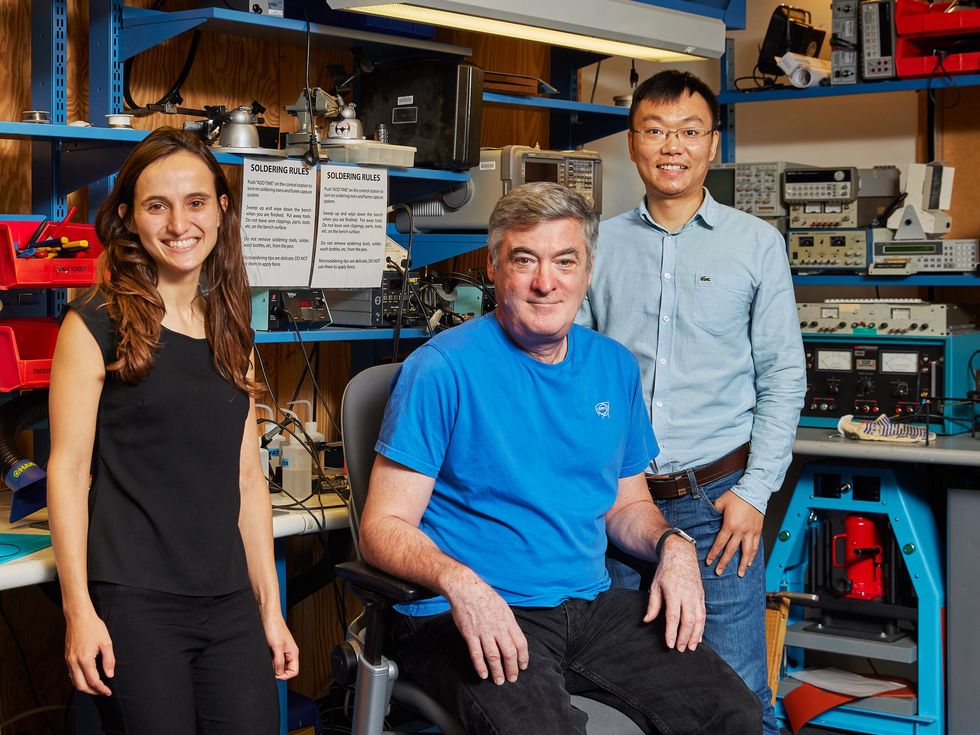 Juliana Cherston and Joe Paradiso of MIT's Responsive Environments Group and Wei Yan of the Fibers@MIT group are part of the team behind the smart-textile experiment launching in February.Bob O'Connor
Juliana Cherston and Joe Paradiso of MIT's Responsive Environments Group and Wei Yan of the Fibers@MIT group are part of the team behind the smart-textile experiment launching in February.Bob O'Connor
Now we're working to nail down just how sensitive the fabric is-that is, what ranges of particle mass and velocity it can register. We're soon scheduled to test our fabric at a Van de Graaff accelerator, which can propel particles of a few micrometers in diameter to speeds of tens of kilometers per second, which is more in line with interstellar dust velocities.
Beyond piezoelectrics, we're also interested in detecting the plumes of electric charge that form when a particle strikes the fabric at high speed. Those plumes contain clues about the impactor's constituent elements. One of our samples on the ISS is an electrically conductive synthetic fur made of silvered Vectran fibers. More typically used to reinforce electrical cables, badminton string, and bicycle tires, Vectran is also a key component in inflatable spacecraft. In our case, we manufactured it like a carpet or a fur coat. We believe this design may be well suited to catching the plumes of charge ejected from impact, which could make for an even more sensitive detector.
Meanwhile, there's growing interest in porting sensored textiles to spacesuits. A few members in our group have worked on a preliminary concept that uses fabrics containing vibration, pressure, proximity, and touch sensors to discriminate between a glove, metallic equipment, and rocky terrain-just the sorts of surfaces that astronauts wearing pressurized suits would encounter. This sensor data is then mapped to haptic actuators on the astronauts' own skin, allowing wearers to vividly sense their surroundings right through their suits.
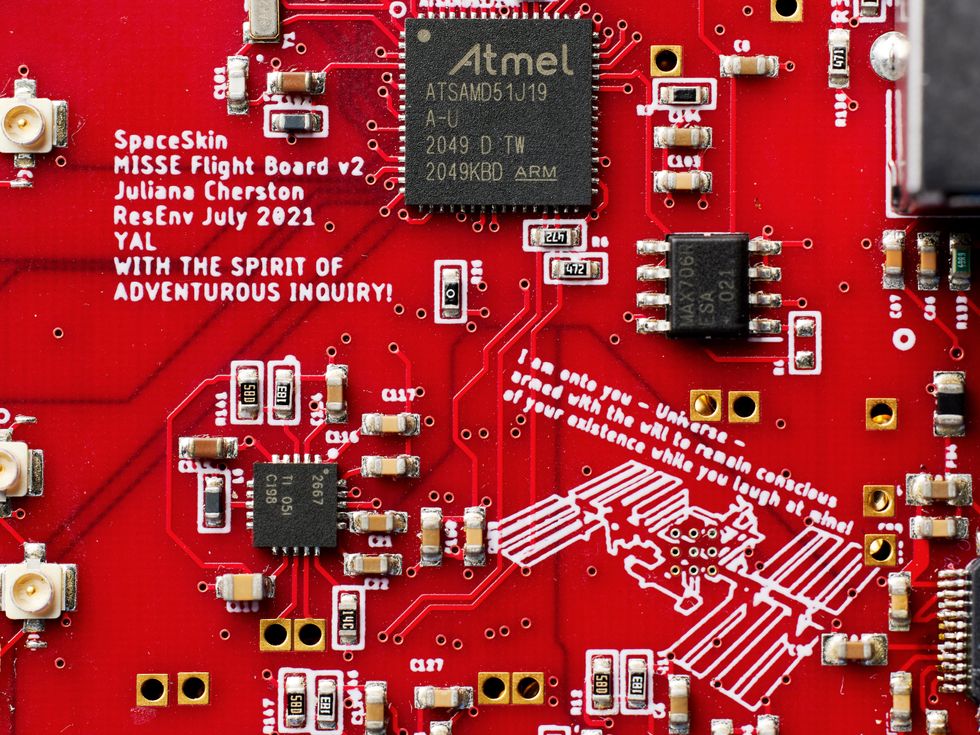 A close-up of the circuit board that will be used to control the powered fabric sensors on the MISSE experiment.Bob O'Connor
A close-up of the circuit board that will be used to control the powered fabric sensors on the MISSE experiment.Bob O'Connor
How else might a sensor-enhanced fabric enhance human engagement with the space environment? For long-duration missions, explorers residing for months inside a spacecraft or habitat will crave experiential variety. Fabric and thin-film sensors might detect the space weather just outside a spacecraft or habitat and then use that data to alter the lighting and temperature inside. A similar system might even mimic certain external conditions. Imagine feeling a Martian breeze within a habitat's walls or the touch of a loved one conveyed through a spacesuit.
To Probe FurtherCherston et al. "Large-Area Electronic Skins in Space: Vision and Preflight Characterization for First Aerospace Piezoelectric E-Textile," Proceedings of SPIE.
Wicaksono, Cherston et al. "Electronic Textile Gaia: Ubiquitous Computational Substrates Across Geometric Scales," IEEE Pervasive Computing.
Yan et al. "Thermally Drawn Advanced Functional Fibers: New Frontier of Flexible Electronics," Materials Today.
Lee, Veysset et al. "Dynamics of supersonic microparticle impact on elastomers revealed by real-time multi-frame imaging," Nature.
Veysset et al. "High-velocity micro-projectile impact testing," Applied Physics Review Letters.
Funase, et al. "Mission to Earth-Moon Lagrange Point by a 6U CubeSat: EQUULEUS," IEEE Aerospace and Electronic Systems Magazine.
To engineer a fabric that can survive extreme conditions, we foresee experimenting with piezoelectric materials that have intrinsic thermal and radiation resilience, such as boron nitride nanotubes, as well as devices that have better intrinsic noise tolerance, such as sensors based on glass fibers. We also envision building a system that can intelligently adapt to local conditions and mission priorities, by self-regulating its sampling rates, signal gains, and so on.
Space-resilient electronic fabrics may still be nascent, but the work is deeply cross-cutting. Textile designers, materials scientists, astrophysicists, astronautical engineers, electrical engineers, artists, planetary scientists, and cosmologists will all have a role to play in reimagining the exterior skins of future spacecraft and spacesuits. This skin, the boundary of person and the demarcation of place, is real estate ripe for use.
This article appears in the December 2021 print issue as "The Smartly Dressed Spacecraft."